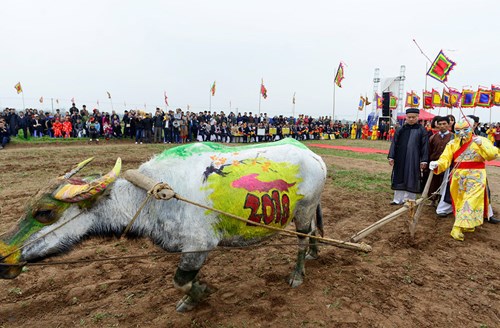February 22, 2018 | 21:06 (GMT+7)
Annual ploughing festival opens in Ha Nam province
The Tich Dien (Ploughing Festival), an annual festival held on the seventh day of the Lunar New Year to pray for a year of bumper harvests, opened in the Red River Delta province of Ha Nam on February 22.
    |
 |
|
The Tich Dien held to pray for a year of bumper harvests. Photo: zing.vn |
The festival dates back to 987 during the Tien Le (Early Le) dynasty when King Le Dai Hanh decided to plough in Doi Son commune, Duy Tien district to encourage rice cultivation in the locality. The practice then became an annual tradition held through many dynasties before falling into oblivion under the reign of King Khai Dinh of the Nguyen Dynasty. It was restored in 2009.
Rituals held within the festival include the procession of a huge drum and King Le Dai Hanh’s ancestral tablet from Long Doi Son pagoda to the foot of the Doi Mountain, where it merges with the processions of the village’s guardian god and the father of Doi Tam drum-making. The joint procession then proceeds to the land where King Le Dai Hanh ploughed to encourage farmers to work diligently.
This is followed by a ceremony to pay respect to the God of Agriculture to pray for a high-yield season and prosperity.
Particularly, a respected elderly farmer representing the local people assumed the role of King Le Dai Hanh to perform praying to the ancestors and the god of farming. The elderly farmer, who was dressed in a nine-dragon hat and royal robe, then descended to the field to plough. He is followed by a crowd throwing green pea, peanut and rice seeds.
Other festive activities are traditional wrestling, drum performances and buffalo decoration.
Source: VNA